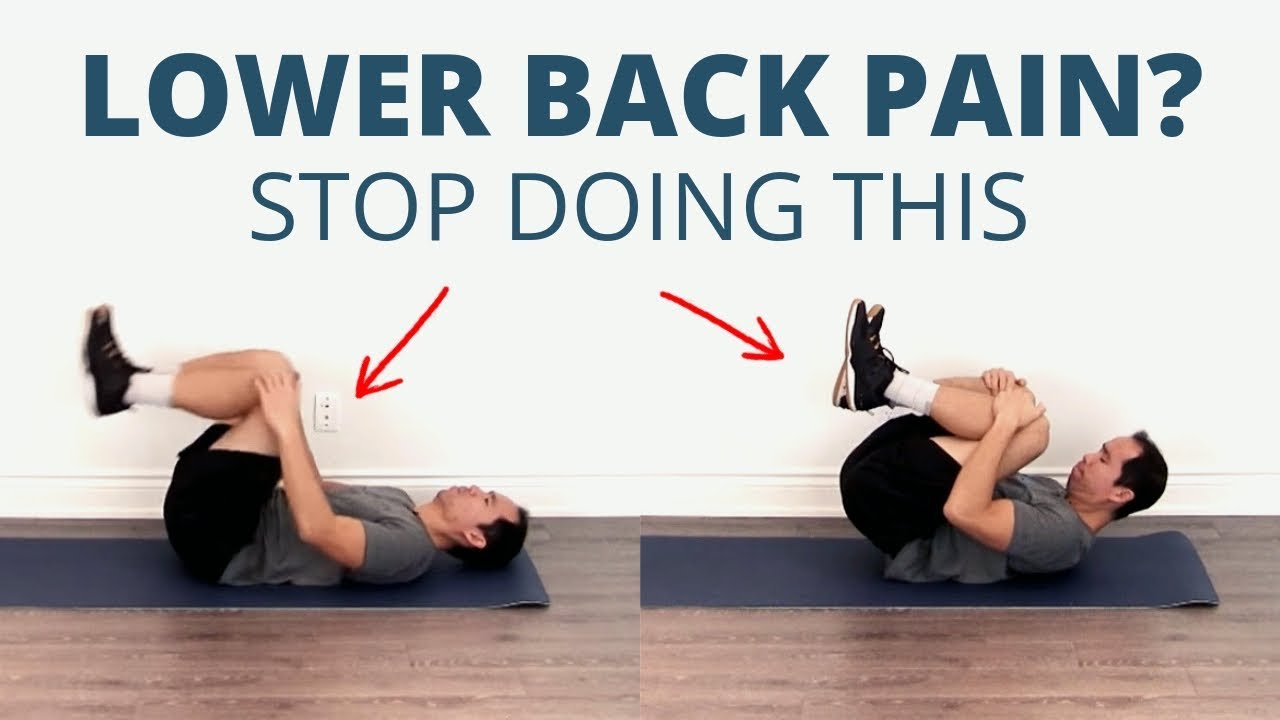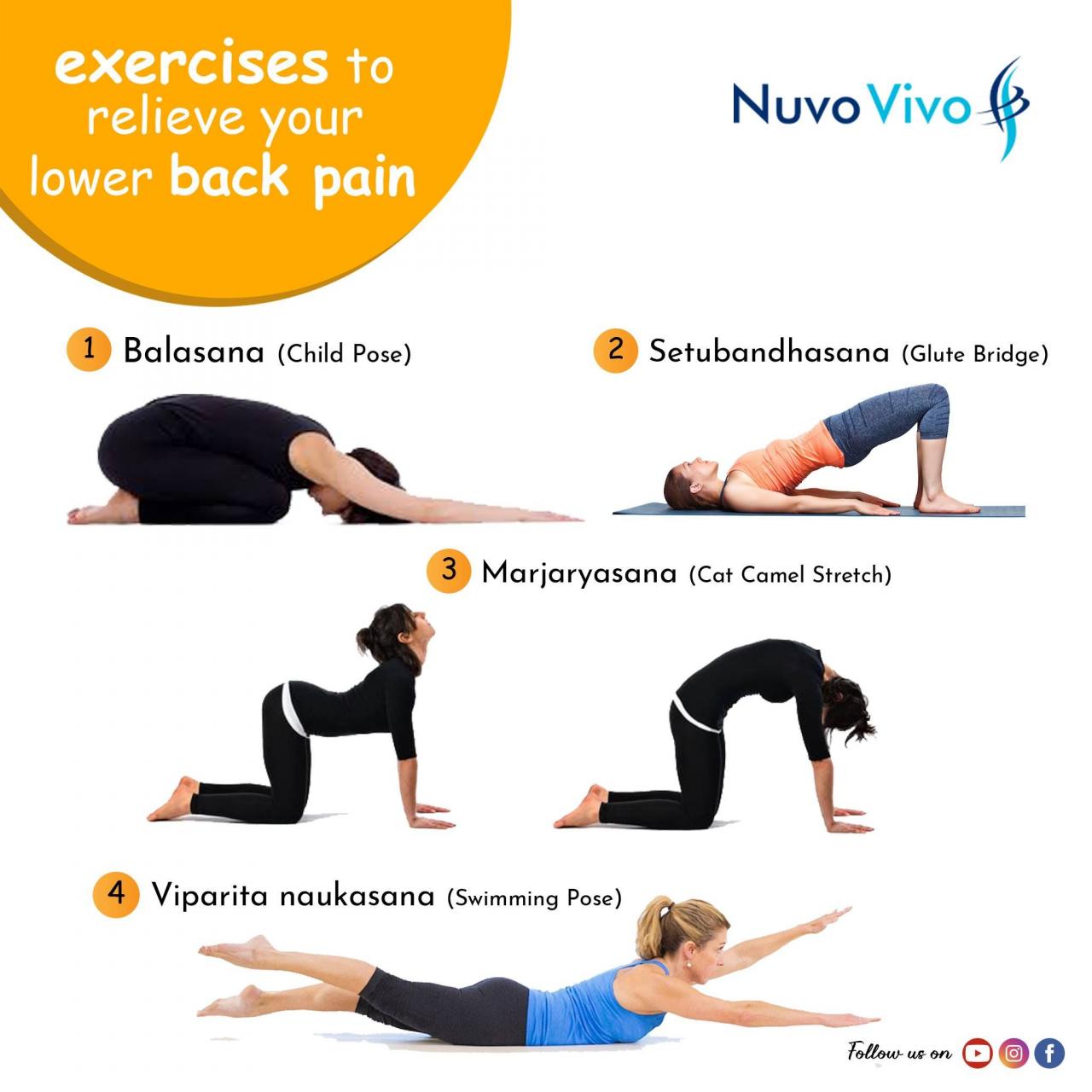
Back pain is a common ailment that can significantly impact daily life. Exercises to relieve lower back pain offer a non-invasive and effective solution to manage this discomfort. This guide explores a range of exercises, stretches, and strengthening techniques to alleviate lower back pain and improve overall well-being.
Understanding Lower Back Pain

Lower back pain is a common problem that affects people of all ages. It can be caused by a variety of factors, including muscle strains, ligament sprains, and herniated discs. Lower back pain can range from mild to severe, and it can have a significant impact on daily life.
There are two main types of lower back pain: acute and chronic. Acute lower back pain typically develops suddenly and lasts for a few days or weeks. Chronic lower back pain lasts for more than three months. Both types of lower back pain can be debilitating, and they can make it difficult to perform everyday activities.
Lower back pain can have a significant impact on daily life. It can make it difficult to work, sleep, and exercise. It can also lead to depression and anxiety.
Exercises for Relieving Lower Back Pain
There are a number of exercises that can help to relieve lower back pain. These exercises are designed to strengthen the muscles around the lower back and improve flexibility.
- Pelvic tilts:Lie on your back with your knees bent and your feet flat on the floor. Tilt your pelvis up so that your lower back presses into the floor. Hold for 5 seconds and then relax.
- Knee-to-chest stretch:Lie on your back with your knees bent and your feet flat on the floor. Bring your right knee to your chest and hold for 30 seconds. Repeat with your left knee.
- Hamstring stretch:Stand with your feet shoulder-width apart. Bend forward at the waist and reach for your toes. Hold for 30 seconds and then relax.
Stretching for Lower Back Pain
Stretching is an important part of any lower back pain treatment plan. Stretching can help to improve flexibility and reduce muscle tension.
- Lower back stretch:Lie on your back with your knees bent and your feet flat on the floor. Pull your knees to your chest and hold for 30 seconds. Relax and repeat.
- Hamstring stretch:Stand with your feet shoulder-width apart. Bend forward at the waist and reach for your toes. Hold for 30 seconds and then relax.
- Quadriceps stretch:Stand with your feet shoulder-width apart. Bend your right knee and grab your right foot with your right hand. Pull your heel towards your buttocks and hold for 30 seconds. Relax and repeat with your left leg.
Strengthening Exercises for Lower Back Pain
Strengthening exercises can help to improve the strength of the muscles around the lower back. This can help to stabilize the spine and reduce pain.
- Plank:Start by lying on your stomach. Raise yourself onto your forearms and toes, keeping your body in a straight line from head to heels. Hold for 30 seconds and then relax. Repeat.
- Bird dog:Start by kneeling on your hands and knees. Extend your right arm forward and your left leg backward simultaneously. Hold for 30 seconds and then relax. Repeat with your left arm and right leg.
- Superman:Lie on your stomach with your arms and legs extended. Lift your arms and legs off the ground simultaneously and hold for 30 seconds. Relax and repeat.
Alternative Therapies for Lower Back Pain
In addition to exercises, there are a number of alternative therapies that can help to relieve lower back pain. These therapies include:
- Acupuncture:Acupuncture is a traditional Chinese medicine technique that involves inserting thin needles into the skin at specific points on the body. Acupuncture is thought to help relieve pain by stimulating the body’s natural pain-relieving mechanisms.
- Massage therapy:Massage therapy can help to relieve muscle tension and pain. Massage therapists use a variety of techniques to massage the muscles around the lower back, which can help to improve circulation and reduce pain.
- Yoga:Yoga is a mind-body practice that can help to improve flexibility, strength, and balance. Yoga poses can also help to relieve lower back pain by stretching and strengthening the muscles around the lower back.
Prevention of Lower Back Pain, Exercises to relieve lower back pain
There are a number of things you can do to help prevent lower back pain, including:
- Maintain a healthy weight:Being overweight or obese can put extra stress on your lower back.
- Get regular exercise:Exercise can help to strengthen the muscles around your lower back and improve your flexibility.
- Use proper posture:When you sit, stand, or walk, make sure to keep your back straight and your shoulders back.
- Lift heavy objects properly:When you lift a heavy object, bend your knees and lift with your legs, not your back.
- Quit smoking:Smoking can damage the discs in your lower back.
Ending Remarks

By incorporating these exercises into a regular routine, individuals can effectively reduce lower back pain, enhance mobility, and improve their quality of life. Remember to consult a healthcare professional before starting any new exercise program, especially if you have any underlying health conditions.
Answers to Common Questions: Exercises To Relieve Lower Back Pain
How often should I perform these exercises?
Frequency depends on individual fitness levels and pain severity. Start gradually and increase repetitions and sets as tolerated.
Maintaining flexibility is crucial for overall well-being, and regular exercise is the key to achieving this goal. Studies have shown that physical activity helps prevent stiffness and pain, especially in the lower back area. If you’re struggling with lower back fat, incorporating exercises specifically designed for this area can be highly beneficial.
Can these exercises cure lower back pain permanently?
While exercises can significantly reduce pain, they may not eliminate it entirely. Consistency and lifestyle modifications are crucial for long-term management.
Are there any contraindications for these exercises?
Consult a healthcare professional if you have any underlying health conditions, recent injuries, or severe pain. Some exercises may not be suitable for everyone.

